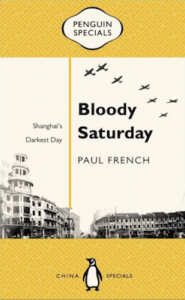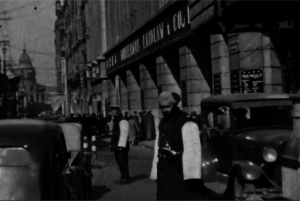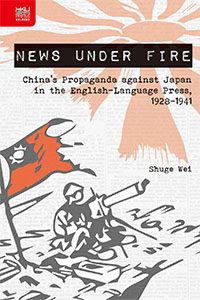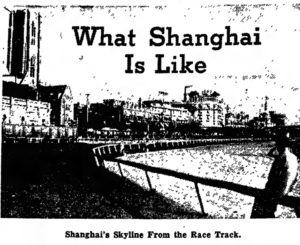Posted: August 8th, 2017 | No Comments »
More bad news, reported in the Beijinger, of hutong destruction – this time Gulou Xidajie. Ostensibly this is of illegal frontages and other structures but is inevitably also taking down hutong architecture. You all know this, but I’ll repeat it again anyway (and I await the usual flurry of emails telling me the hutongs aren’t worth saving, repairable and that all anyone wants is a high rise flat in a distant suburb) – in 1949 (by the Beijing city administrations own numbers) there were 3,050 hutongs. By 1990 this was down to 2,250; by 2004 to 1,300 and by 2012 to 900. The number is now probably around 600, but at least half of those are changed beyond recognition as a hutong, truncated in some way and the new spate of apparently rather random bulldozerings (random in terms of what walls and window spaces etc are being pulled down). This is now a very real and imminent case of architectural extinction…

Posted: August 7th, 2017 | No Comments »
Available in (hopefully) all good book shops in Asia today….the story of Bloody Saturday, 14/8/37, 80 years on from the day world war two came to Shanghai….
Bloody Saturday contains a stunning cast of characters and great period detail. French’s mastery of the era makes for an engaging read – Bookish Asia
Paul French’s Bloody Saturday focuses on a single day in the history of Shanghai, but it is absolutely spellbinding.- Richard J Smith, Los Angeles Review of Books
Stringing together multiple accounts, Paul French’s gripping narrative retells the dreadful events that lead to the death of more than 2,000 people in Shanghai during the second Sino-Japanese war – South China Morning Post


Posted: August 6th, 2017 | No Comments »
Here, from 1936, a Sikh traffic constable of the Shanghai Municipal Police on the junction of Nanking Road (Nanjing East Road) and Szechuen Road (Sichuan Middle Road). Right outside the old Whiteaway and Laidlaw department store ( at no.98, founded 1913 and known to all Shanghailanders as the “Right Away and Paid For”)….Naturally, as it’s 1936, everyone’s driving on the right…

Posted: August 5th, 2017 | No Comments »
Nice to see this Shanghai registered car in 1933 sporting its AA badge on the grill. The car belonged to Richard Martin, a Shanghai Municipal Police officer, here taking a drive out around the city walls of Soochow (Suzhou)…

Posted: August 4th, 2017 | No Comments »
Another in my occasional series on old Shanghai street signage (admit it, you were waiting for another post with bated breath!). We’ve had telegraph pole numbering and a Shanghai Municipal Police ‘No Waiting’ sign now for the amazing Shanghai Public Works Department (PWD) barrier indicating some building works or other disruption, in this case a procession by Anhui Guildsmen through Yangtszepoo (Yangpu) in 1933…

Posted: August 3rd, 2017 | No Comments »
I’ve been waiting a while to read this new book from Shuge Wei….

News under Fire: China’s Propaganda against Japan in the English-Language Press, 1928–1941 is the first comprehensive study of China’s efforts to establish an effective international propaganda system during the Sino-Japanese crisis. It explores how the weak Nationalist government managed to use its limited resources to compete with Japan in the international press. By retrieving the long neglected history of English-language papers published in the treaty ports, Shuge Wei reveals a multilayered and often chaotic English-language media environment in China, and demonstrates its vital importance in defending China’s sovereignty.
Chinese bilingual elites played an important role in linking the party-led propaganda system with the treaty-port press. Yet the development of propaganda institution did not foster the realization of individual ideals. As the Sino-Japanese crisis deepened, the war machine absorbed treaty-port journalists into the militarized propaganda system and dashed their hopes of maintaining a liberal information order.
Shuge Wei is a historian based at the Australian National University. Her research interests include Chinese media history, Chinese political culture, Sino-Japanese War, and grassroots movements in China and Taiwan.
“A superbly researched and well-nuanced account of an overlooked topic: nationalist China’s propaganda system and the multiple ways in which it intersected with the treaty-port foreign-language press of the time. Combining a wealth of archival and newspaper sources, it is destined to be on the ‘must read’ list of all who are interested in state propaganda and news dissemination in the Republican period.â€
—Julia C. Strauss, professor of Chinese politics, SOAS, University of London
“An absorbing and well-sourced study of KMT propaganda efforts to convince the United States to side with China rather than Japan in WWII. The study shows how the KMT, facing a massive power asymmetry compared to its Japanese opponent, managed to effectively use the soft power of foreign propaganda.â€
—Rudolf G. Wagner, senior professor of Chinese studies, Cluster of Excellence Asia and Europe, Heidelberg University, Germany
Posted: August 2nd, 2017 | No Comments »
This is from a puff piece, entitled ‘What is Shanghai Like?’, that appeared in newspapers in 1938 with lots of funny Chinese talking English and nightclubs and all that….right at a time when Shanghai was being invaded and effectively at war!!
Anyway, it’s an interesting perspective from down on the race course looking across to what is now Nanjing Road…

Posted: August 1st, 2017 | No Comments »
Should you happen to be Brazilian and/or Portuguese speaking then the lovely people at Editora Fundamento have just published the Brazilian edition of Midnight in Peking (with a translation by Celso Antonio Almeida)Â – more details here…









